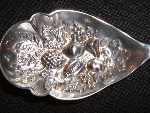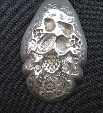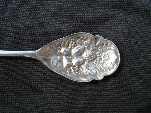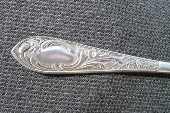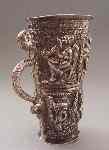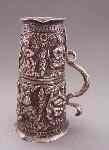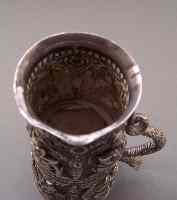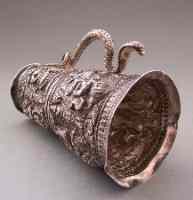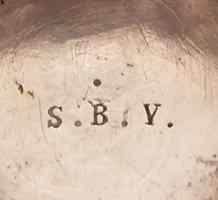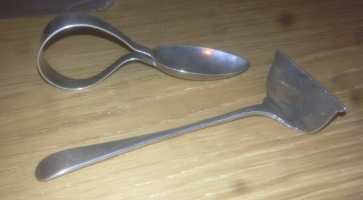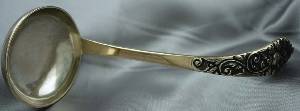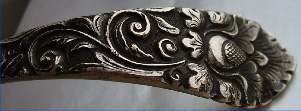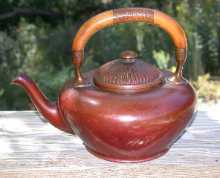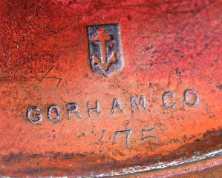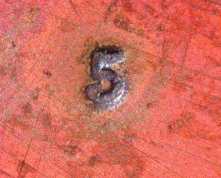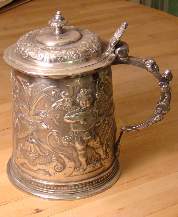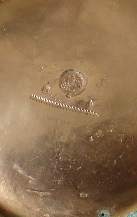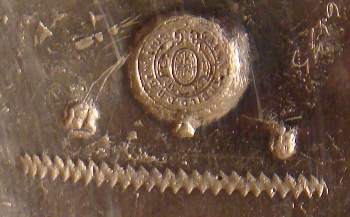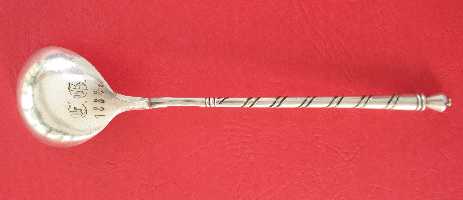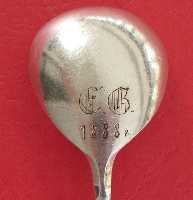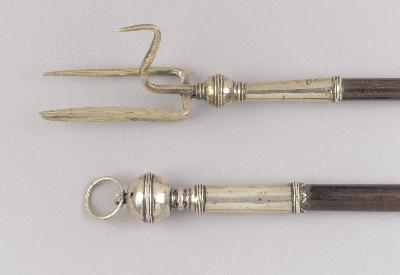
Dorothea Burstyn presents:
Toasting forks 
.....The majority of toasting forks were made of iron,
brass or simple wire, this study only concerns itself
with the use, styles and history of the silver toasting
fork. It has been suggested that the silver toasting
fork was intended to be used in the dining room "to
give employment to amateur cooks" or was handled "by
those who preferred to do their own toasting before the
dining room or sitting room fire". These quotes seem
to suggest that the choice of material - silver - was
determined by the location in which this implement was
to be used. In contrast, modern thought categorizes the
silver toasting fork as kitchenware. The incentive to
choose silver for so many medical and kitchenware
utensils must be found in the hygienic properties of
silver. Besides until the mid-nineteenth century (and
possibly even later), people who could afford silver
toasting forks had servants who did all the food
preparation....
click here 
|
Welcome to new ASCAS members:
Ugo Bazzotti - Italy
Judit Darrah - Canada
Charles Daryl - Australia
Shelah Fondren - USA
Sharon Hoff - USA
Richard Knight - West Wales UK
Patricia Larson - USA
Rex Lloyd - New Zealand
Barbara Romeo - USA
Mike Smith - Thailand
Members' Window # 77
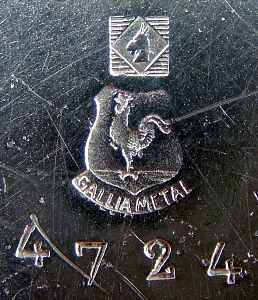
Prof. David N. Nikogosyan
presents:
Marks of European Silver Plate:
VII. Gallia, Alfenide/Christofle, France 
Being a keen collector of silver-plated articles made by the
famous French foundry Christofle, I ignored the items made from
Gallia metal until the day I purchased, at an Internet auction, a
marvellous Art Nouveau piece, probably a butter container,
consisting of the base and its cover. The glass inset was
missing, but I put instead a black cardboard band inside the base
that allowed me to assemble the piece and to enjoy its beauty....
click here 
|
Les Salvage writes:
... Referring to the article by Simon Buxton in your May 2010
Newsletter concerning silver plated ware, you may like to add
that the various indicators of this type of product can also
include just 'A1' with no other references to the process. I
understand that A1 is for the highest grade of silverplate.
I have an electroplated Berry Spoon by John Henry Potter, the
photos of which show a repoussé bowl and a handle with lap-over
edges to a very nice design.
What I would like to know, is what do the first two symbols
mean?
Les Salvage
About the symbols (I presume you refer to S and P gothic
in Potter's mark): the S usually was used to indicate that the
firm was active in Sheffield. This is a common practice used by
Sheffield makers. The "L" was used by some of London Makers and
the "G" by Glasgow makers (and in some cases I saw both "S" and
"L", to indicate that the firm was active in Sheffield and in
London). Instead, I never (or, maybe, only in one case) I saw a
"B" for Birmingham.
In our case the S is coupled to a P: my hypothesis is that the
meaning is "Sheffield Plate" (other suggestions would be
appreciated).
Giorgio Busetto
PS: obviously in other cases the S indicates Son or Sons (but
the "S" is preceded by &)
Barry Laidler writes:
... I wonder if someone would mind helping me with the attached?
From my browsing on the Internet I feel it is Indian Silver,
perhaps Raj period, and might be called a measuring peg.
Obviously it is a double cup of some sort. It has the initials
S.B.Y. (possibly V) stamped inside, on the bottom of the larger
cup. I have begun cleaning it and it looks as if it will come up
superbly well apart from the dents to the rims.
Best regards
Barry Laidler
Gary Price writes:
... Can you identify these items please?
They were made in Birmingham by James Swann and have the date
letter "v" but what were they used for?
I hope you can shed some light on these items.
Yours
Gary Price
Your item is a baby feeding set with spoon and pusher.
Giorgio Busetto
I'm sorry, but I'm unable to identify the maker of your
item.
The ladle is, possibly, of Italian manufacture (but I'm not so
sure). In this case it was made in the period 1870-1935.
Unfortunately there is no published literature about this period
and I have no possibility to identify the mark.
Giorgio Busetto
I believe that the marks of your item are Spanish. I
trust in the help of ASCAS readers for further information
Giorgio Busetto
Lesley Frej writes:
... I am doing some research on my family tree and ancestors
called Grostate. There appears to have been a silverware company
called Grostate & Co in Madras circa 1800s and I was wondering
if you had any further information about them.
Hope you can help!
Best Regards
Lesley
Any information will be welcome.
Giorgio Busetto
Replies to questions
Dorothea Burstyn writes:
Peter Bower's query re German tankard, the sign says
"Galvanische Nachbildung, Gew. Mus.quot; (Gewerbemuseum) -
translated galvanic reproduction, museum of trades.
Galvanic reproductions were in great demands by museums all over
for study purposes. The V&A, London, has a large collection and
also a great display explaining the process.
Best regards,
Dorothea Burstyn
Oskar M. Zurell writes:
About the tankard Replica - Electro-Galvanic plastic,
made by the "Bayerisches Gewerbemuseum" in Nürnberg, Germany.
Nürnberg was, next to Augsburg in the History the leading centre
of metal wares - in Gold, Silver, copper, bronze, brass and tin.
For educational reason, the "Gewerbe-Museum"
("Handicraft-Museum") in Nürnberg (Nuremberg) made in her own
Galvanic Laboratory replica of a huge amount of items - most of
all were replica from historic metal wares; as in yours case.
To obtain a detailed and homogenous copy, it is necessary to use
in the Galvanic Processing on the Anode a pure metal, e.g.
silver, or in this case copper - hence the "verdigris" spots on
the bottom of the tankard. Then after these items were on their
surface plated with pure silver, if the original were silver, or
gilded, if the original were made from gold. In your case the
item is silver plated.
Because it is a replica, so also the maker's mark, town mark and
assayers' zig-zag is copied as well. Actually I couldn't
identify these two marks - also for my eyes they aren't clear
enough.
To prevent that somebody claim, that it is an original - it's
usual, to mark this kind of items very clear, to be a copy.
In this case is in a baroque shield centred the symbol of the
Museum - and in the surrounding circle is written:
"GALV.(anische) NACHBILD.(ung) D.(es) B.(ayerischen)
GEWERBEMUS.(eum)"
(Galvanic Reproduction of the Bavarian Handicraft Museum)
That's not a drinking association motto!
The item number or production number is scratched: 6415 - so
maybe the tankards first station could be traced back; if the
register isn't lost in the war times (especially in WWII).
The original tankard could be made in XVII century.
A very brief history of the former "Bayerisches Gewerbemuseum
Nürnberg":
Founded 1869 - since 1987 integrated in the "Germanisches
National Museum". www.gnm.de
Kind regards,
Oskar M. Zurell
Postnikov writes:
To the Russian spoon in the late newsletter I have to say
the following:
The town mark (see photo) is thought to be maybe one of the town
marks from Odessa for the year 1890. Very, very dubious!
The silversmith
 is in this form not known, the assay master CO does not exist in
Odessa.
is in this form not known, the assay master CO does not exist in
Odessa.
The whole mark looks dubious to me. The monogram is Latin EB
(Gothic) which was often used by customers from the Baltic
states - but here it is crudely engraved and would not have been
accepted. Further is the year 1888 with the Cyrillic letter for
"year" engraved. Latin letters and Russian letter???
For me it is a fake spoon!
Kind regards
Postnikov
Kari Helenius writes:
Old Kostroma Town mark used to have a cross resembling
the one on the spoon. The cross was used in different forms from
1746 till 1870. Especially the cross on the 1746 mark is quite
close. It could be possible that the cross has been used also
1888.
There is this mark 719 Assay master "Cb" (1893). Could it be the
same mark?
It is difficult to judge if the master's mark is IR or IG. There
is a master's mark 913 IG, Ivan Gabrilov 1898.
(The numbers refer to Postnikova-Lossevas book)
Best regards
Kari
Oskar M. Zurell writes:
The Continental European "Plated" producer had as quality
sign the indication of gram. The American and English Plated
producer had a letter code for their "Plated" quality; e.g. "A1"
or "AI" as their ever best quality = quality grade of about
medium level of Continental Europeans.
Lower level was "A", next level was "B", and then next level was
"C", and lowest level "D".
A1 = Superior Quality = 32 grams on 12 pieces = 2 2/3 grams per
table spoon or table fork
A = Standard Quality = 24 grams on 12 pieces = 2 grams per table
spoon or table fork
B = Third Quality = 16 grams on 12 pieces = 1 1/3 grams per
table spoon or table fork
C = Fourth Quality = 12 grams on 12 pieces = 1 grams per table
spoon or table fork
D = Fifth Quality = 6 grams on 12 pieces = 0 1/2 grams per table
spoon or table fork
(Example by Barker Brothers, Birmingham, around 1900).
Kind regards
Oskar M. Zurell
In this column we present a page
obtained from makers' brochures, books, auction catalogs,
advertising or whatever other printed paper, related to silver,
that may be of interest for ASCAS members.
The images will be published at a "low resolution" level and for
private and personal use only
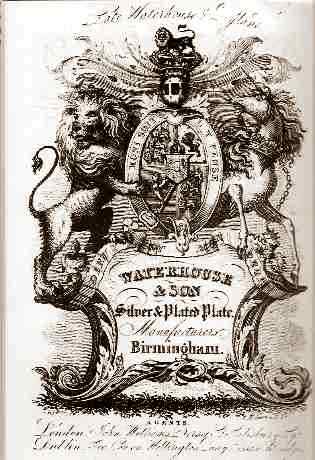
|
This month we present an ancient trade card of
WATERHOUSE & SON
LATE WATERHOUSE & RYLAND
Silver & Plated Plate
Manufacturers
Birmingham
The firm had Agents in London and Dublin
|
"A WORD per MONTH"
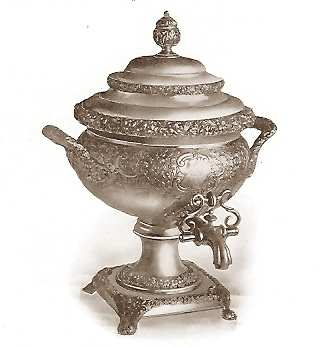
|
HOT WATER URN
TEA URN
A type of
vessel for dispensing, originally, hot water for making
tea, that enable the content to be dispensed without
lifting or tilting the heavy piece. This item held a
place on the sideboards of the wealthier classes from
about the middle of the 18th century.
Tea urns were made first of all without any heating
accessories. Then appliances were introduced for keeping
the water hot by the aid of a heating iron fixed in the
upper part of the base. This iron penetrated into the
lower part of body. Another system was a tube, fixed on
to the base, which ran right up the body of the urn,
carrying the heat from the charcoal to the body....
more
|
"A SILVERSMITH per MONTH"
|
|
ADIE & LOVEKIN
ADIE & LOVEKIN LTD
The firm began its business
as Adie & Lovekin and was active in Snape Street,
Hockley, Birmingham (before 1872).
The firm became Adie & Lovekin Ltd in 1889.
The company manufactured a wide range of silver fancy
goods at the end of the 19th century and had a factory
in Regent Street, Hockley, Birmingham. In 1894 they
commissioned Mansell & Mansell to design a new factory
at 23, Frederick Street, Birmingham which became known
as 'Trafalgar Works'....
more
|
"A BOOK ON MY SHELF"
In this column we present books, new
or ancient, dealing with silver in all its aspects (history,
marks, oddities...). This isn't a "book review" but only a fair
presentation of some useful "tools" that anyone may have in the
shelf of his bookcase.
ASCAS members are invited to contribute to this column
(click to enlarge images)
The "book on my shelf" of this month presents:
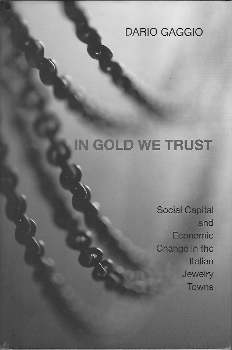
|
IN GOLD WE TRUST
Social Capital and Economic Change
in the Italian Jewelry Towns
by
Dario Gaggio
Princeton University Press
Princeton And Oxford
2007
In Gold We Trust is a historical and
sociological account of how, by the late 1960s,
three small Italian towns had come to lead the
world in the production of gold jewelry -even
tough they had virtually no jewelry industry
less than a century before, and even tough Italy
had western Europe's most restrictive gold laws.
It is a distinctive but paradigmatic story of
how northern Italy performed its post-World War
II economic miracle by creating localized but
globally connected informal economies, in which
smuggling, tax evasion, and the violation of
labour standards coexisted with ongoing
deliberation over institutional change and the
benefits of political participation...
|
"A CREST per MONTH"
In this column we present images and
descriptions of Crests and Mottoes of British, Irish and
Scottish families as engraved on silver items.
BRODIE
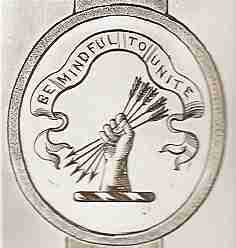
|
The crest of James-Campbell
Brodie, Esquire, of Lethen and Coulmony, Nairn. A hand
with a sheaf of arrows and motto "Be mindful to unite".
The crest was found in a silver tea box marked by John
Parker I and Edward Wakelin, London 1770
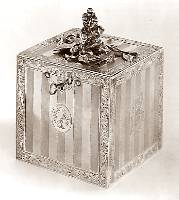
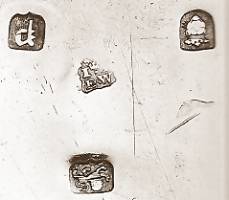
|
Closing our October 2010 edition of ASCAS
Newsletter I hope you have appreciated its content.
Your comments, suggestions and advice will be of great help.
My thanks to Dorothea Burstyn,
Jayne Dye, Lesley Frej, Christophe Ginter, Kari Helenius, M.
Heumann, Barry Laidler, Prof. David N. Nikogosyan, Postnikov,
Gary Price, Les Salvage, Michael Smith, Patrick Street, Oskar M.
Zurell for their invaluable contributions.
Giorgio Busetto
Secretary
DISCLAIMER AND PRIVACY POLICY
ASCAS is a community of people having a common
interest in antique silver.
It is a non-profit association without commercial links.
Membership is open to whomever has a true interest in
this subject matter.
ASCAS has no real property and no fees are requested nor
accepted from members.
ASCAS keeps in touch with its members only through
periodical newsletters, e-mails and web-site updating
and ignores and is not responsible for any other
activity pursued by its members.
Likewise, ASCAS is not responsible for opinions,
evaluation and images displayed, and in any form
published or supplied for publication, by its members
who, in any case, maintain the property of their works
and assure the respect of national and international
legislation about Intellectual Property.
ASCAS does not have the full addresses of its members
(only town, country and e-mail address are requested for
membership).
ASCAS handles and protects with care its members' e-mail
addresses, will not disclose the addresses to third
parties, will use this information only to reply to
requests received from members and for communications
strictly related to its activity.
These rules are expressly accepted by submitting the
membership request.
|
|
 newsletter
# 77 October 2010
newsletter
# 77 October 2010
 is in this form not known, the assay master CO does not exist in
Odessa.
is in this form not known, the assay master CO does not exist in
Odessa.






